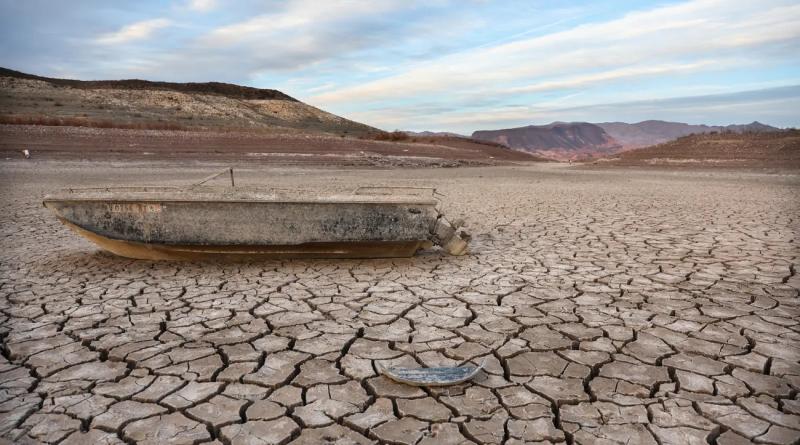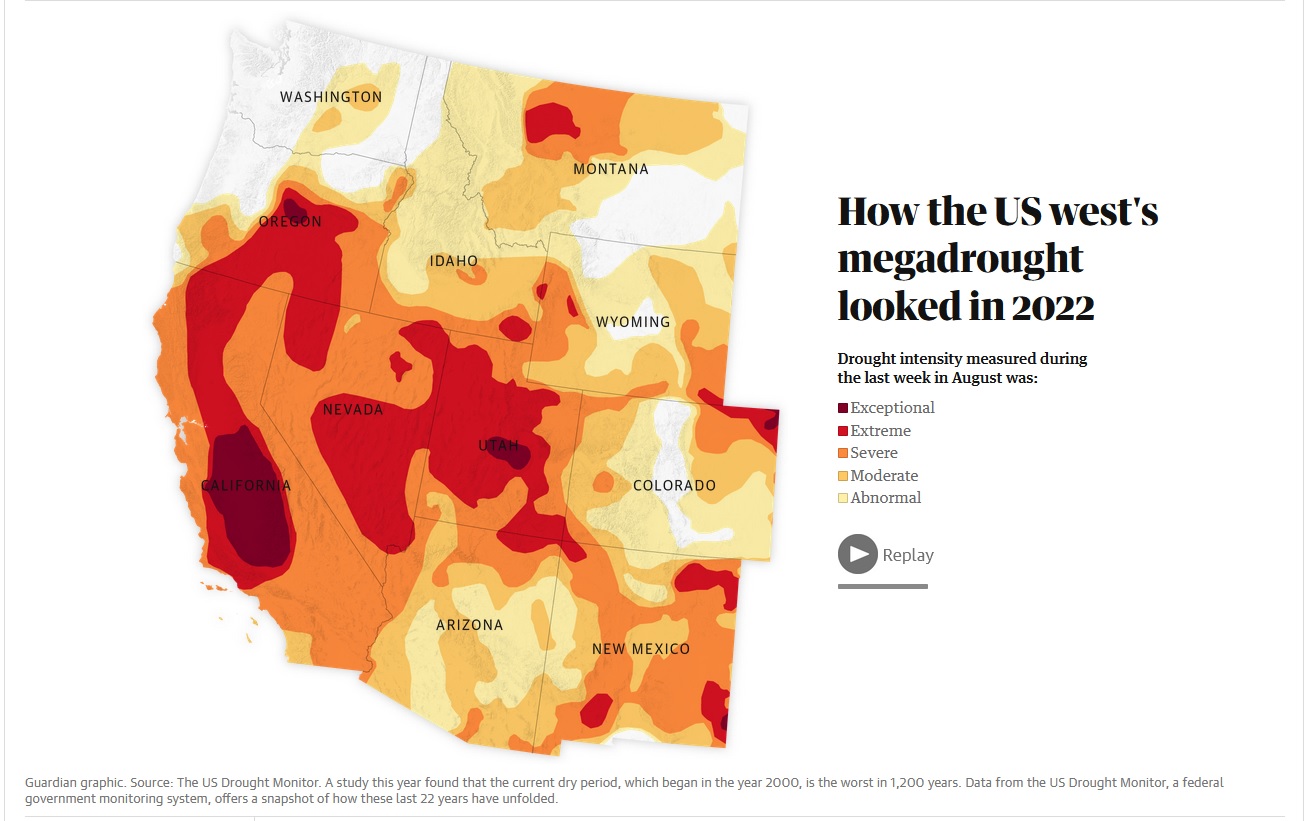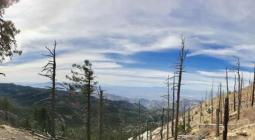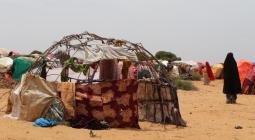Megadrought in the American south-west: a climate disaster unseen in 1,200 years

When the Nasa climatologist James Hansen testified before Congress in June 1988 about a warming planet, the temperature in Washington DC hit a record 100F. It was a summer of unprecedented heatwaves, and 40 states were grappling with drought.
His warning was seen as a historic wake-up call – but instead of heeding the existential smoke alarm, the US removed the batteries and kept on cooking.
Nearly four decades later, the consequences of a sweltering Earth are hitting home in the US south-west and mountain west – comprising states from California to Colorado. Over the past two decades, extreme heat and dwindling moisture levels have converged to create a “megadrought” deemed the driest period in 1,200 years.
The west is now in uncharted territory, as once singular conditions become the norm. Its mightiest reservoirs – Lake Mead and Lake Powell – are at record low levels and steadily shriveling. Prolonged, triple-digit heatwaves are making cities like Phoenix, Arizona, and Las Vegas, Nevada, almost unlivable during summers. And wildfires now spark year-round as parched forests and grasslands are more primed than ever to burn.

A recent analysis by the Washington Post found that, in some parts of the south-west, average annual temperatures have already risen by more than 1.5C, a threshold widely considered the tipping point at which devastating consequences for people and the environment take hold.
The extraordinary conditions offer a warning of what lies ahead for other arid regions that cross this line. It is also a reminder that despite all the modern innovations to circumvent an unforgiving climate, drought may once again have the final say unless drastic steps are taken quickly.
“We were given an excellent warning by climate scientists,” says Bill McKibben, the journalist turned climate activist. “And, yet, instead of mustering the will to do something about it, our political and economic systems rallied to do nothing.”
In a new series, the Guardian will explore the consequences of megadrought on the communities and environments of the US south-west, where cattle ranchers, Indigenous peoples and tourists alike are seeing their daily lives upended.
‘More severe than any previous drought’
The researchers behind the study that identified the current megadrought did so by analyzing one of nature’s greatest record keepers: tree rings.
While drought is a natural part of the south-west’s climate, looking at the relationship between tree rings and soil moisture found that the current period of aridity, which began in the year 2000, is unprecedented since AD800. The 2022 study, published in the journal Nature Climate Change, attributed 42% of the last two decades’ hot and dry conditions to global heating.
Tim Kohler, an archaeologist and professor at Washington State University, says the current megadrought is different from prehistoric dry periods. “This one seems to be more severe than any of the previous droughts and just as long,” he says. “But the really bad news is all the previous megadroughts took place without the influence of increasing greenhouse gases. Now we are playing a new ballgame and scientists don’t know what to expect.”
Recent research has shown how such compelling forces are playing out on the ground.
A report last February from the United Nations Intergovernmental Panel on Climate Change (IPCC) detailed how wildfires ravaging the south-west’s ponderosa pine forests are fueling a dangerous “positive feedback cycle”. Instead of acting as a “carbon sink” that absorbs CO2, explains Camille Parmesan, an ecologist who contributed to the report, some forests can actually become generators of greenhouse gases as they burn, in turn driving more heating.
“At some point, we may have put such a long, heavy train into motion that the positive feedback cycles will be locked in and continue to produce CO2 regardless of what humans do,” Parmesan says. “We have evidence this is starting and that is really scary.”
Another alarming aspect of the current dry period is something Parmesan calls “synergistic compounding effects”: essentially when the consequences of climate change occur simultaneously and turn what might otherwise have been a normal weather-related event – such as a fire or a heatwave – into a disaster.One such example is in Colorado, on the western slope of the Rocky Mountains that feeds Lake Powell and Lake Mead. The slope is experiencing less snowfall and higher temperatures. But on top of that, dust storms in nearby Utah have grown bigger and more frequent as the soil dries out; the dust then blows on the mountain, making the snow melt even faster. These two interlocking phenomena are making the drought even worse.
This compounding phenomenon also played out last spring and summer with large wildfires in northern Arizona and northern New Mexico. A dearth of snowfall led to a parched forest floor where drought and pests had already killed many trees. That combined with record heat, low humidity and hurricane-force winds to create unstoppable wildfires.
Kathy Oliver found herself in the path of one such blaze, the Tunnel fire, near Flagstaff, Arizona, in April. Oliver, who operates a local horse sanctuary, awoke one windy morning to the smell of smoke and was forced to flee almost immediately. The fast-moving fire, which went on to scorch nearly 27,000 acres (109 sq km), consumed her home and belongings within hours. “I could feel the fire’s heat at my back when I was loading the last few horses,” says Oliver of her narrow escape with her 21 horses, three dogs and two cats. “Climate change hit me full on.”
‘Earth is our source of life and not a resource’
As the west squares up to the worst drought in its modern history, there are lessons to be learned from the past.
Kohler has spent more than three decades studying prehistoric Puebloan civilizations in the south-west, and he knows what the stress of a megadrought can do to a community. He says that large Puebloan societies historically evolved during century-long periods of reliable precipitation when farming conditions were favorable, then “fell apart” during intense megadroughts that lasted 20 to 40 years. For instance, when thriving settlements such as Chaco Canyon and Mesa Verde were hit by a tough drought in the 1100s, survivors dispersed to smaller communities in what is now Arizona and New Mexico.
But what has puzzled Kohler is evidence from his archaeological research that shows not every prolonged drought led to the demise of a Puebloan society. He says it was only the socially polarized communities that appeared to collapse during a climate crisis. “What I think happened is that some people in these villages had more wealth, or maize production, than others,” explains Kohler. Over time, tensions built between the haves and have-nots. “If there were pre-existing social divisions during a climatic downturn, then you had the potential for violence and village life was thrown into chaos.”
Kohler notes that when he found evidence of village members living at the same social level, it appeared they were able to survive a similarly challenging drought by “pulling together and making things work”.
There are troubling echoes in the resource wars of today – such as the current stalemate over the Colorado River, where western state leaders have been unable to agree on how to cut back water use as supplies dwindle. The deadlock poses a dire threat to a reservoir system that provides water to 40 million people and supports a large portion of US agriculture.
Cultural memories of extreme climate events live on in the stories of North America’s Indigenous people, who see human survival as dependent on maintaining harmony with all living things. It is a lesson that the Lakota spiritual leader Arvol Looking Horse says the descendants of European colonizers have yet to learn.
Looking Horse holds a divinely ordained position among the plains tribes, similar to the Dalai Lama in Tibetan Buddhism. For him, the forces that put the desires of the fossil fuel industry over the warnings of scientists are the same as the forces that invaded Indigenous homelands centuries ago in a quest for natural resources.
“For Native people, everything on the Earth has a spirit – the wind, the water, the trees, the air – and we are connected to it,” says Looking Horse. “Man has gone too far in abusing Mother Earth. Now Mother Earth is sick. She has a fever.”
Looking Horse says the current state of climate change was predicted in a Lakota prophecy and brings humanity to a crossroads. “We have to stop abusing the Earth and allow her to heal,” he says. “We have no choice because now our lives depend on it. The Earth is our source of life and not a resource.”
The Biden administration’s landmark climate legislation that was signed into law in August will help in the fight. Alongside efforts to cut greenhouse gas emissions, the legislation will also provide $550m over the next decade to improve water access to disadvantaged communities in the south-west, especially Native American reservations. It also provides $4bn to fund drought-mitigation programs in Colorado River basin states, such as initiatives to encourage municipal water conservation and reduce agricultural water waste.
In the south-west, the challenges of climate change also present new opportunities. With both Lake Mead and Lake Powell at record-low capacity, environmental groups have proposed storing whatever is left of Lake Powell’s water in Lake Mead, thereby reducing the amount of water lost to evaporation. This measure would also return the canyons of Lake Powell to their pre-reservoir state, creating landscapes that act as a carbon sink and potentially even a new national park.

While ranching and growing water-intensive crops like alfalfa may no longer be sustainable in desert states, the region offers excellent locations for new solar and wind enterprises. And as maintaining a green lawn becomes increasingly impossible in places like Utah, homeowners are forced to finally let go of the pastoral aesthetic brought to the south-west by European colonizers and embrace prickly native plants.
Thirty-four years after Hansen warned lawmakers that climate change had arrived, America is grappling with the consequences of inaction.
McKibben remains undaunted.
“We have to move extremely fast to have any chance at all in limiting the rise in global temperature,” says the author. “New studies keep bringing bad news but I remain hopeful. The antidote to despair is activism.”
-
This is the second of several stories in our coverage of the megadrought. You can view the other stories here.
As heat, fires and water wars become the norm, the Guardian explores the fallout of prolonged drought in a multi-part series
- Read the first story in the series





